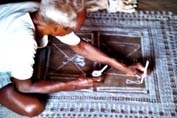|
In
India, people from the tribal communities are
called « adivasi », which means « first
people ». Yet we know almost
nothing of Indian tribal art. For nearly two thousand years, the
prolific flowering of sacred, Buddhist, Jain, Hindu and Muslim arts
almost entirely eclipsed tribal art in the sub-continent. The art of the
Naga people is one of the few surviving testimonies. The sculptures,
finery and architecture of this tribe of former head-hunters, converted
to Christianity in the 1950s, rival with the finest pieces of tribal art
from Africa and Oceania. Other examples have been uncovered by
outstanding ethnological research, notably work done by Elwin Verrier in
the 1930s on the Gond tribe in the central Indian state of Madya Pradesh.
Unfortunately, very few ancient pieces have been kept and so there is
little chance of seeing them. Luckily, thanks to the efforts of the
Indian government and occasional help from enlightened art lovers, India¹s
tribal art has not completely vanished.
In the 1970s, aware
that this part of its artistic
heritage was steadily disappearing, the Indian government provided aid
for its various ethnic communities. Government agents supplied paper and
canvas so artists could make a lasting record of traditionally ephemeral
ritual arts. The new media were easy to transport and display and helped
make these forms of ancestral art known outside their traditional
geographical areas. The paintings and drawings are exhibited and sold in
state stores, bringing in extra income for these often destitute
communities. Although they were mainly intended for the tourist trade, a
number of works caught the eye
(next page)
|
|
|
|
|
Jivya Soma Mashe, 1997. Rice pasta and acrylic on paper, 13 x 18 cm. |
|
|
Gond mask collected by Elwin Verrier, 1936.
|
|

